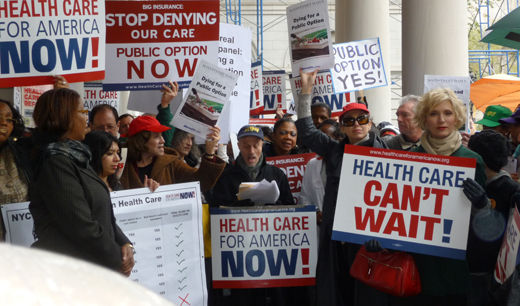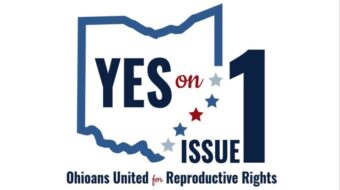
Mark Hannay, a leading NY health care reform activist, said in an interview the People’s World this week, “we need to put the health care fight into a larger context of the fight over change.”
“Health care is the wedge issue right now on that whole bigger agenda. If we can break through on health care then the rest of that change agenda can move, and if we don’t break through on health care it won’t.”
Hannay’s organization, Metro NY Health Care for All, is currently working with other groups to plan a public action with that bigger context in mind. The “March for Change,” set to take place in NYC on February 20, will be an answer from the grassroots to the question of “what kind of change are we going to see happen in health care, and who’s going to set the agenda … a similar paradigm extends to climate change, jobs agenda, immigration reform, financial services reform, the whole broad change agenda.”
To the $64,000 question on the minds of so many – can meaningful health care reform pass this year? – Hannay said yes, although he cautions that it will be only be a step in a long process.
“You have these political moments that open up, like now, when we have opportunities to make major advances as a nation,” he explains. “Then we’ll go through the phase of implementing them, and then at some point another national window will present itself, and we’ll just keep moving down the field.”
So what does meaningful mean?
To Hannay, it has two sides: “first are the policy issues – how much ground can we gain…can we lay a foundation for a new structure or new options?” The other aspect is the political fight: “Can we bend, if not break, the inordinate influence of the vested special interests” over the health care reform process. “Simply beating them…would be a victory.”
The needed policy changes are “expansions of coverage, steps to make healthcare more affordable, steps to hold the insurance industry accountable.”
Hannay stressed the importance of amplifying the voices of everyday people. “We should be working together to project the public interest voice in this,” he states, “to finish up the health care reform fight so that when we have a final bill for the President to sign, there’s as much public interest reflected in it as we can possibly get.”
About the idea of “starting over,” Hannay says, “first of all, we wouldn’t start over on anything really significant for quite a while … and in the meantime, the crisis is going to get a lot worse; in the meantime, the other side gains the upper hand and political momentum [which they would use] to move in a really bad direction…of instituting even more private market hegemony in the health care system.”
A public health insurance option is important, and although “it’s a long shot, that doesn’t mean that we stop talking about it.” Even if the final bill does not include a public option, there are “other ways to move forward… For example, if they allow states flexibility on implementation and in setting up these new exchanges, there may be ways that states can move forward on public option kinds of approaches.”
Hannay adds that “this concept of a public option is really in lieu of what all of us would ideally prefer to see happen and that is a fully publicly administered, publicly financed health insurance program at the national or state level.”
Hannay started working on the health care reform issue in 1991, “cutting his teeth” on the Clinton effort. He’s still optimistic, however, that something will get done this year. “It’s just a question of how far they’re going to go, and how much of an impediment the special interests are going to be,” he says.
He takes both a long and a wide view: “Even when you look at countries that have got some sort of national health care programs, they all do it differently; they range from fully public systems to mixed systems, to more private systems, etc. And even then, when they get their systems in place, there are always efforts to improve them, make them work better, get rid of the stuff that doesn’t work so well. And also defend them, because there are always efforts to roll them back.
“And so people should understand that the fight for health care for all is sort of never-ending, and that’s just the way it’s going to be.”
Photo: Mark Hannay, Director of Metro New York Health Care for All Campaign, addresses a press conference on the stairs of New York’s City Hall to thank the 12 of 13 NYC members of Congress who voted for the House health care reform bill, H.R 3962, the Affordable Health Care for America Act. (Elena Mora/PW)












Comments